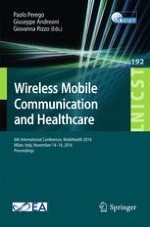2017 | Buch
Wireless Mobile Communication and Healthcare
6th International Conference, MobiHealth 2016, Milan, Italy, November 14-16, 2016, Proceedings
herausgegeben von: Paolo Perego, Giuseppe Andreoni, Giovanna Rizzo
Verlag: Springer International Publishing
Buchreihe : Lecture Notes of the Institute for Computer Sciences, Social Informatics and Telecommunications Engineering
